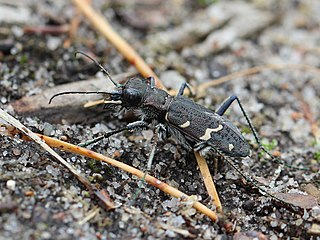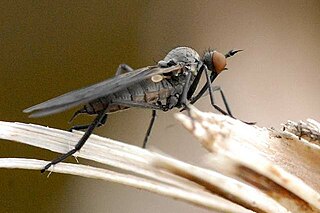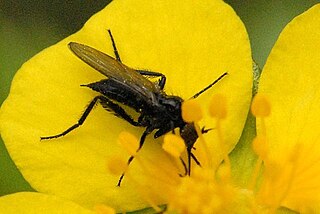
The Heleomyzidae is a small family of true flies in the insect order Diptera. Over 740 described species of Heleomyzidae occur in about 76 general distributed throughout the world.

The Chamaemyiidae are a small family of acalyptrate flies with less than 200 species described worldwide. The larvae of these small flies are active and predatory and are often used for biological control of aphids, scale insects, and similar pests. Chamaemyiid fossils are poorly represented in amber deposits, but a few examples are known from the Eocene epoch onwards.

Cicindela sylvatica is a tiger beetle, commonly known as the wood tiger beetle or heath tiger beetle. It is the largest of the British tiger beetles with a length of between 15–19 millimetres (0.59–0.75 in). It is black in colour with a blue tinge, more pronounced on the underside, and sometimes appears with a bronze sheen.

Rhamphomyia sulcata is a species of dance flies, in the fly family Empididae. It is included in the subgenus Rhamphomyia. It is found in most of Europe, except the Balkan Peninsula.

Rhamphomyia albidiventris is a species of dance flies, in the fly family Empididae. It is included in the subgenus Pararhamphomyia. It has a limited distribution. It has been recorded from Great Britain, Germany, Austria, Slovakia, Bosnia, Finland and central Russia.

Rhamphomyia crassirostris is a species of dance flies, in the fly family Empididae. It is found in most of Europe, east to Poland and Hungary. It is absent from Italy and the Balkan Peninsula.

Empis planetica is a species of dagger flies, in the fly family Empididae. It is included in the subgenus Empis. It is found in Ireland and Great Britain and from Scandinavia south to Italy.

Empis variegata is a species of dance flies, in the fly family Empididae. It is included in the subgenus Leptempis. It is found from the Benelux, through Germany to Switzerland, Austria, the Czech Republic, Slovakia and Hungary. It has also been recorded from central Russia.

Hybomitra montana, the slender-horned horsefly, is a species of horse flies in the family Tabanidae.

Chamaemyia is a genus of flies in the family Chamaemyiidae. It is the type genus of its family.

Chamaemyia flavipalpis is a species of fly in the family Chamaemyiidae. It is found in the Palearctic. and North Africa.
Chamaemyia nigripalpis is a species of fly in the family Chamaemyiidae. It is found in the Great Britain. Its body length is about 2.5 mm (0.10 in). The type series was collected from a patch of Calamagrostis epigejos where it was repeatedly observed through May to August.
Chamaemyia paludosa is a species of fly in the family Chamaemyiidae. It is found in Europe and North America. Its body length is about 3 mm (0.12 in).
Chamaemyia triorbiseta is a species of fly in the family Chamaemyiidae. It is found in Scotland.
Chamaemyia bicolor is a species of fly in the family Chamaemyiidae. It is found in the Palearctic.
Chamaemyia flavoantennata is a species of fly in the family Chamaemyiidae. It is found in the Palearctic.
Chamaemyia hungarica is a species of fly in the family Chamaemyiidae. It is only found in Hungary.
Chamaesyrphus caledonicus is a Palearctic hoverfly.
Chamaemyia taiwanensis is a species of fly in the family Chamaemyiidae. It is found in Taiwan and is the only known representative of its genus there.









